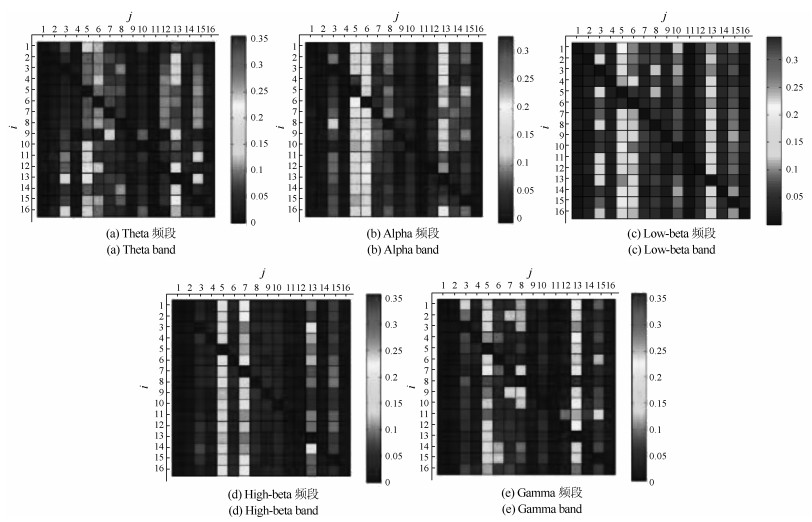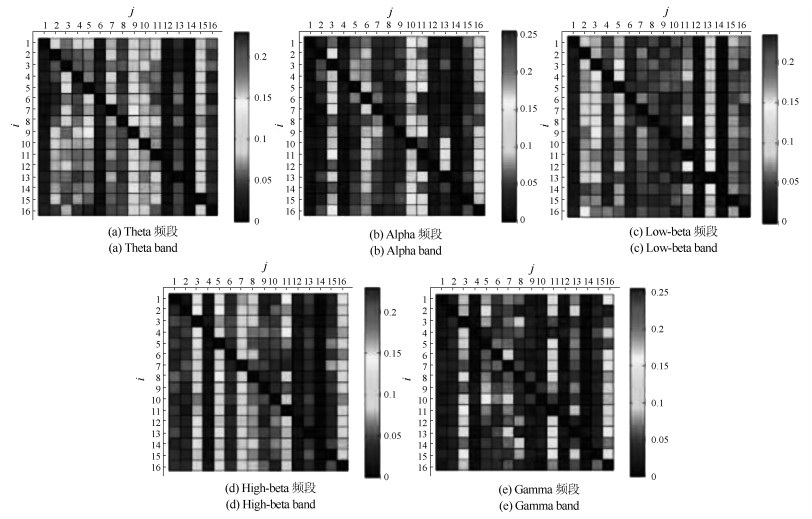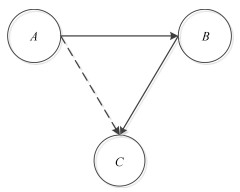Study on the Effect of Autistic Children's Auxiliary Intervention Based on Brain Functional Network Analysis
-
摘要: 脑功能网络是分析复杂网络之间连接关系的一种有效方法, 对脑功能障碍分析具有重要意义. 本文基于频域Granger因果分析的定向传递函数(Direction-transfer function, DTF), 构建了各频段的脑功能网络. 采用图论方法分析最佳阈值下经颅直流电刺激(Transcranial direct current stimulation, tDCS)干预前后孤独症(Autism spectrum disorder, ASD)儿童脑网络的平均度、全局效率和平均局部效率等特征, 并对比了经颅直流电刺激对孤独症儿童脑功能状态辅助干预效果. 结果发现刺激前组在各频段的图论特征均低于刺激后组($P<0.05$), 其中Theta频段和低-beta频段的局部效率统计性差异显著, 表明在一定程度上tDCS干预是ASD儿童治疗的有效手段.Abstract: The brain functional network is an effective method to analyze the connection relationship between complex networks, which is of great significance to the analysis of brain dysfunction. In this paper, the brain function network of each frequency band is constructed based on the direction-transfer function (DTF), of frequency domain Granger causality analysis. Graph theory method was used to analyze the network average degree, global efficiency and average local efficiency of brain network of autism spectrum disorder (ASD) children in two groups pre-/post-transcranial direct current stimulation (tDCS) under the optimal threshold values, and compare the auxiliary intervention effect of tDCS on brain function status in ASD children. The results showed that the graph theory characteristics of the pre-tDCS group were lower than those of the post-tDCS group in each frequency band ($P<0.05$), and there were significant statistical differences in local efficiency in Theta and Low-beta bands. It is suggested that tDCS intervention is an effective method for the treatment of ASD children to a certain extent.
-
Key words:
- Autism spectrum disorders /
- transcranial direct current stimulation /
- brain function network /
- direction transfer function
1) 本文责任编委 张道强 -
表 1 各频段下刺激前后两组ASD儿童全脑DTF总和
Table 1 Total global brain DTF of ASD children in both groups before and after stimulation
DTFsum Theta Alpha Low-beta High-beta Gamma Before 14.88 $ \pm $ 0.015** 14.86 $ \pm $ 0.011*** 14.82 $ \pm $ 0.020*** 14.84 $ \pm $ 0.012** 12.41 $ \pm $ 0.054*** After 14.96 $ \pm $ 0.006 14.95 $ \pm $ 0.005 14.93 $ \pm $ 0.006 14.91 $ \pm $ 0.005 12.98 $ \pm $ 0.084 表 2 Theta频段平均度、全局效率、平均局部效率阈值统计表
Table 2 Threshold statistics of theta band average, global efficiency, average local efficiency
Theta $ D $ $ E_{Glob} $ $ E_{Loc} $ $ p<0.05 $* 0.001 $ \sim $ 0.081 0.001 $ \sim $ 0.078 0.095 $ \sim $ 0.1 0.001 $ \sim $ 0.058 $ p<0.01 $** 0.001 $ \sim $ 0.080 0.001 $ \sim $ 0.008 0.01 $ \sim $ 0.013 0.001 0.002 0.01 $ \sim $ 0.053 0.072 $ \sim $ 0.074 0.099 0.1 $ p<0.005 $*** 0.051 $ \sim $ 0.077 0.014 $ \sim $ 0.047 表 3 Alpha频段平均度、全局效率、平均局部效率阈值统计表
Table 3 Threshold statistics of alpha band average, global efficiency, average local efficiency
Alpha $ D $ $ E_{Glob} $ $ E_{Loc} $ $ p<0.05 $* 0.001 $ \sim $ 0.045 0.052 $ \sim $ 0.059 0.001 $ \sim $ 0.038 0.001 $ \sim $ 0.083 $ p<0.01 $** 0.003 $ \sim $ 0.012 0.018 $ \sim $ 0.021 0.006 $ \sim $ 0.013 0.015 0.002 $ \sim $ 0.083 0.047 0.049 $ \sim $ 0.067 $ p<0.005 $*** 表 4 Low-beta频段平均度、全局效率、平均局部效率阈值统计表
Table 4 Threshold statistics of low-beta band average, global efficiency, average local efficiency
Low-beta $ D $ $ E_{Glob} $ $ E_{Loc} $ $ p<0.05 $* 0.001 $ \sim $ 0.063 0.093 $ \sim $ 0.1 0.001 $ \sim $ 0.042 0.088 $ \sim $ 0.1 0.001 $ \sim $ 0.072 $ p<0.01 $** 0.002 $ \sim $ 0.012 0.021 $ \sim $ 0.025 0.003 $ \sim $ 0.013 0.093 $ \sim $ 0.1 0.002 $ \sim $ 0.004 0.012 $ \sim $ 0.042 0.027 0.038 0.046 $ \sim $ 0.048 $ p<0.005 $*** 0.018 0.025 $ \sim $ 0.03 0.032 $ \sim $ 0.038 表 5 High-beta频段平均度、全局效率、平均局部效率阈值统计表
Table 5 Threshold statistics of high-beta band average, global efficiency, average local efficiency
High-beta $ D $ $ E_{Glob} $ $ E_{Loc} $ $ p<0.05 $* 0.001 $ \sim $ 0.056 0.092 $ \sim $ 0.1 0.001 $ \sim $ 0.053 0.098 $ \sim $ 0.1 0.001 $ \sim $ 0.038 $ p<0.01 $** 0.002 $ \sim $ 0.03 0.032 $ \sim $ 0.034 0.002 $ \sim $ 0.018 0.022 $ \sim $ 0.024 0.002 0.003 0.014 $ \sim $ 0.018 0.036 0.01 0.011 $ p<0.005 $*** 表 6 Gamma频段平均度、全局效率、平均局部效率阈值统计表
Table 6 Threshold statistics of gamma band average, global efficiency, average local efficiency
Gamma $ D $ $ E_{Glob} $ $ E_{Loc} $ $ p<0.05 $* 0.001 $ \sim $ 0.083 all 0.001 $ \sim $ 0.017 0.026 $ \sim $ 0.036 0.038 $ p<0.01 $** 0.002 $ \sim $ 0.078 all 0.002 0.003 0.028 0.029 $ p<0.005 $*** 0.046 $ \sim $ 0.071 0.053 $ \sim $ 0.095 注: all表示Eglob在阈值全范围内差异显著度均满足$ p<0.05 $*和$ p<0.01 $**. 表 7 各频段下刺激前后两组受试儿童脑网络各图论参数的阈值
Table 7 Threshold of graph parameters of brain network in two groups of children before and after stimulation
Theta Alpha Low-beta High-beta Gamma T 0.045 0.038 0.025 0.036 0.029 D ** * ** ** ** $ \rm{E_{Glob}} $ * * * * ** $ \rm{E_{Loc}} $ *** ** *** * ** 注: 显著度*$ p<0.05 $, **$ p<0.01 $, ***$ p<0.001 $ 表 8 最佳阈值下刺激前后脑网络平均度
Table 8 Average degree of brain network before and after stimulation under optimal threshold
频段 Before After Theta 13.44 $ \pm $ 0.389 14.65 $ \pm $ 0.300** Alpha 15.59 $ \pm $ 0.526 16.69 $ \pm $ 0.343* Low-beta 16.92 $ \pm $ 0.609 18.52 $ \pm $ 0.393** High-beta 16.81 $ \pm $ 0.580 18.42 $ \pm $ 0.402** Gamma 16.78 $ \pm $ 0.519 18.56 $ \pm $ 0.379** 注: 显著度*$ p<0.05 $, **$ p<0.01 $, ***$ p<0.001 $ 表 9 最佳阈值下刺激前后脑网络全局效率
Table 9 Global efficiency of pre-and hindbrain network stimulation under optimal threshold
频段 Before After Theta 0.54 $ \pm $ 0.017 0.58 $ \pm $ 0.013* Alpha 0.62 $ \pm $ 0.021 0.66 $ \pm $ 0.013* Low-beta 0.65 $ \pm $ 0.024 0.70 $ \pm $ 0.015* High-beta 0.65 $ \pm $ 0.022 0.70 $ \pm $ 0.016* Gamma 0.68 $ \pm $ 0.023 0.76 $ \pm $ 0.014** 注: 显著度*$ p<0.05 $, **$ p<0.01 $, ***$ p<0.001 $ 表 10 最佳阈值下刺激前后脑网络局部效率
Table 10 Local efficiency of pre-and hindbrain network stimulation under optimal threshold
频段 Before After Theta 0.90 $ \pm $ 0.004 0.91 $ \pm $ 0.003*** Alpha 0.91 $ \pm $ 0.002 0.92 $ \pm $ 0.002** Low-beta 0.93 $ \pm $ 0.002 0.94 $ \pm $ 0.002*** High-beta 0.93 $ \pm $ 0.001 0.94 $ \pm $ 0.002* Gamma 0.89 $ \pm $ 0.002 0.76 $ \pm $ 0.002** 注: 显著度*$ p<0.05 $, **$ p<0.01 $, ***$ p<0.001 $ -
[1] Zablotsky B, Black L I, Maenner M J, Schieve L A, Blumberg S J. Estimated prevalence of autism and other developmental disabilities following questionnaire changes in the 2014 national health interview survey. National Health Statistics Reports, 2015, 2015(87): 1-21 http://pdfs.semanticscholar.org/92c2/2987bdb4397ef53b8e2b0b8a7bda432a0900.pdf [2] 姚小雪, 兰继军, 朱海腾. 孤独症谱系障碍儿童心理理论的影响因素研究进展. 中国特殊教育, 2014(10): 34-39 doi: 10.3969/j.issn.1007-3728.2014.10.006Yao Xiao-Xue, Lan Ji-Jun, Zhu Hai-Teng. The factors influencing the theory of mind in children with autism spectrum disorders. Chinese Journal of Special Education, 2014(10): 34-39 doi: 10.3969/j.issn.1007-3728.2014.10.006 [3] Brian J, Bryson S E, Garon N, Roberts W, Smith, I M, Szatmari P. Clinical assessment of autism in high-risk 18-month-olds. Autism, 2008, 12(5): 433-434 doi: 10.1177/1362361308094500 [4] Johnson C P, Myers S M. Identification and evaluation of children with autism spectrum disorders. Pediatrics, 2007, 102(5): 1183-215 [5] Wang J, Barstein J, Ethridge L E, Mosconi M W, Takarae Y, Sweeney J A. Resting state EEG abnormalities in autism spectrum disorders. Journal of neurodevelopmental disorders, 2013, 5(1): e472-e486 http://www.researchgate.net/profile/Lauren_Ethridge/publication/256663899_Resting_state_EEG_abnormalities_in_autism_spectrum_disorders/links/004635265683b3170c000000.pdf [6] 孙小棋, 李昕, 蔡二娟, 康健楠. 改进模糊熵算法及其在孤独症儿童脑电分析中的应用. 自动化学报, 2018, 44(9): 1672-1678 doi: 10.16383/j.aas.2018.c170334Sun Xiao-Qi, Li Xin, Cai Er-Juan, Kang Jian-Nan. Improved fuzzy entropy and its application in autism. Acta Automatica Sinica, 2018, 44(9): 1672-1678 doi: 10.16383/j.aas.2018.c170334 [7] Bressler S L, Menon V. Large-scale brain networks in cognition: Emerging methods and principles. Trends in Cognitive Sciences, 2010, 14(3): 277-290 http://scsnl.stanford.edu/documents/Bressler_Large-Scale_Brain_10.pdf [8] Murias M, Webb S J, Greenson J, Dawson G. Resting state cortical connectivity reflected in EEG coherence in individuals with autism. Biological Psychiatry, 2007, 62(3): 270-273 doi: 10.1016/j.biopsych.2006.11.012 [9] Coben R, Mohammadrezazadeh I, Cannon R L. Using quantitative and analytic EEG methods in the understanding of connectivity in autism spectrum disorders: A theory of mixed over- and under-connectivity. Frontiers in Human Neuroscience, 2014, 8(104): 45 http://europepmc.org/articles/PMC3935255/ [10] Green S A, Hernandez L, Bookheimer S Y, Dapretto M. Salience network connectivity in autism is related to brain and behavioral markers of sensory overresponsivity. J Am Acad Child Adolesc Psychiatry, 2016, 55(7): 618-626 doi: 10.1016/j.jaac.2016.04.013 [11] 孙金秀. 基于静息态脑电的孤独症谱系障碍儿童脑网络研究[硕士学位论文]. 天津医科大学, 中国, 2016Sun Jin-Xiu. A Study of Brian Network based on Resting-state EEGs in Children with Autism Spectrum Disorder [Master thesis], Tianjin Medical University, China, 2016 [12] Schneider H D, Hopp J P. The use of the bilingual aphasia test for assessment and transcranial direct current stimulation to modulate language acquisition in minimally verbal children with autism. Clinical Linguistics & Phonetics, 2011, 25(6-7): 640 http://www.ncbi.nlm.nih.gov/pubmed/21631313 [13] Amatachaya A, Auvichayapat N, Patjanasoontorn N, Suphakunpinyo C, Ngernyam N, Aree-Uea B. Effect of anodal transcranial direct current stimulation on autism: A randomized double-blind crossover trial. Behavioural Neurology, 2014, 2014: 1-7 http://www.onacademic.com/detail/journal_1000037930044610_9847.html [14] 李昕, 安占周, 李秋月, 蔡二娟, 王欣. 基于多重多尺度熵的孤独症静息态脑电信号分析. 自动化学报, 2020, 46(6): 1255-1263 doi: 10.16383/j.aas.c170687Li Xin, An Zhan-Zhou, LI Qiu-Yue, Cai Er-Juan, Wang Xin. Autistic resting EEG signals analysis based on multiple multi-scales entropy. Acta Automatica Sinica, 2020, 46(6): 1255-1263 doi: 10.16383/j.aas.c170687 [15] 张毅, 尹春林, 蔡军, 罗久飞. Bagging RCSP脑电特征提取算法. 自动化学报, 2017, 43(11): 2044-2050 doi: 10.16383/j.aas.2017.c160094Zhang Yi, Yin Chun-Lin, Cai Jun, Luo Jiu-Fei. Bagging RCSP algorithm for extracting EEG feature. Acta Automatica Sinica, 2017, 43(11): 2044-2050 doi: 10.16383/j.aas.2017.c160094 [16] Kamiński M J, Blinowska K J. A new method of the description of the information flow in the brain structures. Biological Cybernetics, 1991, 65(3): 203-210 doi: 10.1007/BF00198091 [17] Schneider T, Neumaier A. Estimation of parameters and eigenmodes of multivariate autoregressive models. Acm Transactions on Mathematical Software, 2001, 27(1): 27-57 doi: 10.1145/382043.382304 [18] He B, Dai Y, Astolfi L, Babiloni F, Han Y, Lin Y. eConnectome: A MATLAB toolbox for mapping and imaging of brain functional connectivity. Journal of Neuroscience Methods, 2011, 195(2): 261-269 doi: 10.1016/j.jneumeth.2010.11.015 [19] Bernhardt B C, Bonilha L, Gross D W. Network analysis for a network disorder: The emerging role of graph theory in the study of epilepsy. Epilepsy & Behavior, 2015, 50: 162-170 http://www.researchgate.net/profile/Boris_Bernhardt/publication/277876504_Network_analysis_for_a_network_disorder_The_emerging_role_of_graph_theory_in_the_study_of_epilepsy/links/55a7271b08aeb4e8e646d396.pdf [20] Korzeniewska A, Magorzata M, Kamiński M, Blinowska K J, Kasicki S. Determination of information flow direction among brain structures by a modified directed transfer function (dDTF) method. Journal of Neuroscience Methods, 2003, 125(1): 195-207 http://www.researchgate.net/profile/Anna_Korzeniewska/publication/7169982_Determination_of_information_flow_direction_among_brain_structures_by_a_modified_directed_transfer_function_(dDTF)_method/links/0912f50316e0a989dc000000.pdf [21] 蔡二娟. 孤独症儿童脑电分析与经颅直流电刺激干预研究[硕士学位论文], 燕山大学, 中国, 2018Cai Er-Juan. The Research on Analysis of EEG in Autistic Children and Direct Electrical Stimulation Intervention[Master thesis], Yanshan University, China, 2018 -





 下载:
下载:




